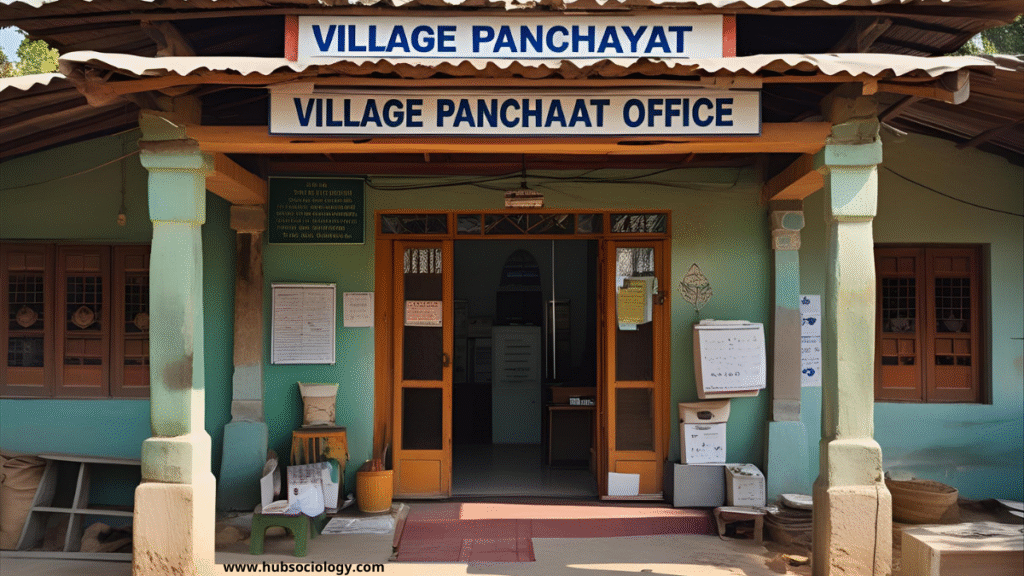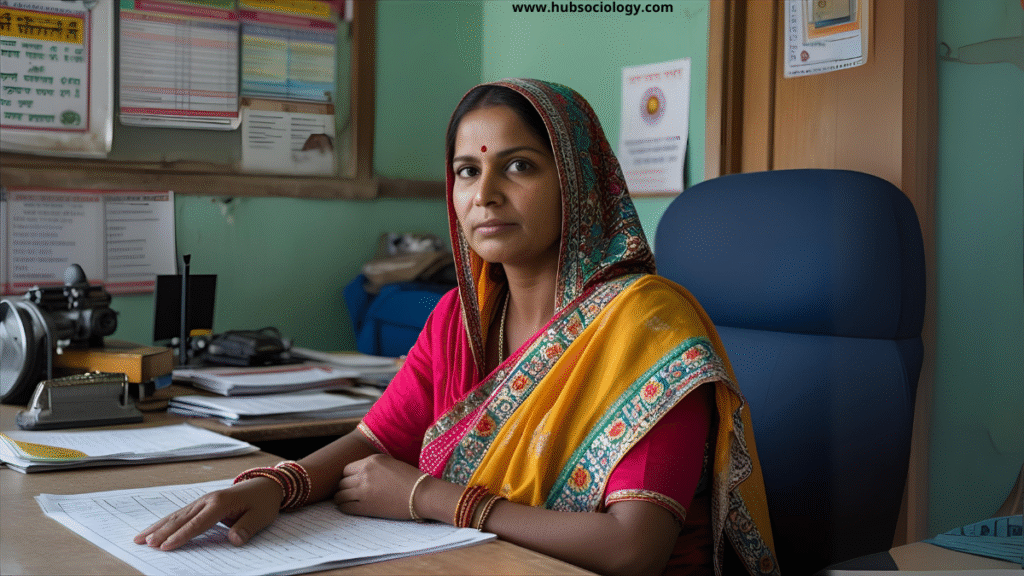Introduction of Panchayati Raj Institutions
The introduction of Panchayati Raj Institutions (PRIs) in India through the Balwant Rai Mehta Committee report of 1957 and its subsequent adoption, starting with Rajasthan on October 2, 1959, is often narrated as a political and administrative event—the decentralization of power. However, to view it merely through this lens is to miss its profound sociological significance.
The establishment of PRIs was not just an administrative restructuring; it was a monumental, state-sponsored social experiment aimed at nothing less than the radical reconfiguration of India’s deepest social hierarchies at the grassroots level. It was an attempt to transplant the modern, egalitarian ideal of democracy onto the ancient, rigid, and feudal soil of rural India. The consequences of this experiment, therefore, offer a rich, complex, and often contradictory tapestry of social change, resistance, and adaptation.

Table of Contents of Panchayati Raj Institutions
The Sociological Blueprint: Democracy as a Disruptive Force
The ideological underpinnings of Panchayati Raj were deeply sociological. Post-independence India was a nation of villages, but these villages were not the idyllic, harmonious communities of nationalist imagination. They were, as sociologist M.N. Srinivas described, steeped in the hierarchies of caste, class, and patriarchy. Power was traditionally concentrated in the hands of the upper-caste landed gentry (the so-called “dominant castes”), while vast sections of the population—Dalits, Adivasis, Other Backward Classes (OBCs), and women—were systematically excluded from any decision-making process.
The Balwant Rai Mehta Committee’s vision was consciously disruptive. By proposing a three-tier structure of local self-government (Gram Panchayat, Panchayat Samiti, Zila Parishad) with elected representatives, the state was intentionally creating a new, parallel structure of authority. This new structure derived its legitimacy not from ascriptive status like birth or caste, but from the universal adult franchise. Theoretically, this opened the door for the subversion of traditional power. A Dalit or an OBC, empowered by numbers and the ballot, could now challenge the authority of the upper-caste landlord in the village chaupal. This was the “silent revolution” in the making—a revolution not of violence, but of procedural change with transformative social potential.
The Consequence: Between Empowerment and Entrenchment
The six-decade journey of PRIs reveals a fascinating sociological dialectic—a constant push and pull between the empowering potential of democratic institutions and the resilient capacity of traditional social structures to co-opt them.
1. The Awakening and Assertion of Marginalized Groups:
The most significant sociological consequence has been the political awakening of the backward and marginalized castes. The PRI became a tangible arena for political apprenticeship. It provided a platform for leadership development, negotiation, and understanding the mechanics of governance for those who had been historically denied such opportunities. Over time, especially after the 73rd Amendment in 1992 which mandated reservations, the social composition of Panchayats began to change dramatically.

The monopoly of the dominant castes was broken in many regions. Scholars like Francine Frankel and M.S.A. Rao documented how in states like Karnataka and West Bengal, the PRI became a vehicle for the upward mobility of OBCs and a space for Dalit assertion. This was not just about holding office; it was about gaining a voice in decisions related to water, roads, employment schemes (like MGNREGA), and land—resources that were traditionally controlled by the elite.
2. The Phenomenon of Co-option and Elite Capture:
However, the revolution was far from complete. Sociology teaches us that power rarely relinquishes its hold easily; it adapts. This is precisely what happened in countless villages. The traditional elite quickly learned the rules of the new game. They began to field pliable candidates from within reserved categories (proxies or puppets), often from their own clientelistic networks, to ensure their interests were still served.
In many cases, the mere presence of a marginalized individual in the seat of the Sarpanch did not translate into real power, as they faced intense social boycotts, threats, and were often mere rubber stamps for the influential figures operating behind the scenes. This “elite capture” of PRIs demonstrated the limitations of a purely institutional approach to social change without a concurrent transformation in economic and social relations.
3. The Paradox of Women’s Reservation:
The mandate for 33% reservation for women (raised to 50% in many states) is perhaps the most studied sociological aspect of PRIs. It forced a massive entry of women into the political sphere, challenging deep-seated patriarchal norms. Initially, many of these women were seen as proxies for their husbands (“sarpanch patis” or husband of the woman Sarpanch). Yet, the very act of occupying public space, attending meetings, handling budgets, and engaging with government officials had a transformative effect.
Numerous studies by sociologists like Niraja Gopal Jayal reveal a process of political learning and empowerment. Many women representatives, after an initial period of hesitation, began to assert their agency, prioritizing issues like drinking water, sanitation, girls’ education, and domestic violence—issues that were previously invisible on the local political agenda. This created a new, albeit contested, model of female leadership in rural India.

4. The Reconfiguration of Conflict and Caste Solidarity:
PRIs did not eliminate caste; they politicized it in a new way. The electoral process at the local level often sharpened caste identities as voting blocs were mobilized along caste lines. However, it also led to the fragmentation of monolithic caste categories. The PRI elections fostered new alliances across castes based on political expediency, creating more complex political landscapes.
Furthermore, the competition for control over local resources and development funds often redirected conflict from the purely social (caste prejudice) to the political (who gets the contract for the road, which hamlet gets the handpump). While this could lead to intense and sometimes violent factionalism, it also meant that the locus of conflict shifted to a democratic arena with established, albeit imperfect, rules for resolution.
5. The Incomplete Decentralization and the Shadow of the State:
Sociologically, the autonomy of PRIs has always been constrained. The real financial and bureaucratic power largely remains with the state government officials—the Block Development Officer (BDO), the District Collector, and line departments. This creates a patron-client relationship where the elected local representative must often navigate and appease the state bureaucracy to get things done. This undermines the very principle of self-governance and reinforces a culture of dependency and negotiation with higher authorities, rather than fostering genuine grassroots-led planning and implementation.
Conclusion on Panchayati Raj Institutions
The introduction of Panchayati Raj in 1959 set in motion a process of social churning whose waves are still felt today. Its greatest sociological achievement is not that it created perfect, equitable democracies in every village—it did not. Its achievement lies in having ruptured the naturalness of traditional authority. It legally and institutionally established the principle that a landless laborer has the same right to govern as a landlord, and a woman the same right as a man.
The consequences are a mixed bag of tangible empowerment and stubborn resistance. The PRIs became a battleground where the modern ideal of citizenship, based on rights and equality, clashed with the ancient realities of hierarchy ascription. While traditional structures have shown a remarkable ability to adapt and persist, the genie of political consciousness cannot be put back in the bottle. The marginalized have tasted power, however fleeting, and have learned to use the language of rights and representation to make their claims.
The Panchayati Raj experiment, therefore, remains the most ambitious and ongoing project of social engineering in independent India. It is a living laboratory where the deepest contradictions of Indian society—between democracy and hierarchy, between modernity and tradition, between individual rights and community identities—are played out daily in thousands of village squares. It is unfinished, often messy, and frequently disappointing, but it has irrevocably altered the social fabric of rural India, making its polity more vibrant, more contested, and infinitely more complex. The silent revolution continues, one Panchayat meeting at a time.
Do you like this this Article ? You Can follow as on :-
Facebook – https://www.facebook.com/hubsociology
Whatsapp Channel – https://whatsapp.com/channel/0029Vb6D8vGKWEKpJpu5QP0O
Gmail – hubsociology@gmail.com
Topic Related Questions on Panchayati Raj Institutions
5 Marks Questions on Panchayati Raj Institutions (Short Answer)
- What was the sociological significance of introducing Panchayati Raj Institutions (PRIs) in 1959?
- Explain the role of the Balwant Rai Mehta Committee in shaping the Panchayati Raj system.
- What does M.N. Srinivas’s description of Indian villages reveal about caste and power structures?
- Define the term “elite capture” in the context of PRIs.
- Why is the women’s reservation in PRIs considered both a paradox and a breakthrough?
10 Marks Questions on Panchayati Raj Institutions (Medium Answer)
- Discuss how the Panchayati Raj system created a “silent revolution” in rural India.
- Evaluate the role of PRIs in the political awakening of marginalized groups such as Dalits, OBCs, and Adivasis.
- How did caste solidarity and conflict get reconfigured after the introduction of PRIs?
- Explain the sociological challenges posed by the limited financial and bureaucratic autonomy of PRIs.
- Assess the contribution of PRIs in promoting women’s participation and leadership in rural governance.
15 Marks Questions on Panchayati Raj Institutions (Long Answer/Essay Type)
- Critically examine the dialectic between empowerment and elite capture in the functioning of Panchayati Raj Institutions since 1959.
- “Panchayati Raj was not just an administrative reform, but a social revolution.” Discuss with sociological examples.
- Analyze the impact of the 73rd Constitutional Amendment (1992) on the social composition and functioning of Panchayati Raj Institutions.
- To what extent has the Panchayati Raj experiment succeeded in democratizing rural India? Illustrate with sociological perspectives.
- Examine the Panchayati Raj system as a site where democracy and hierarchy, modernity and tradition, rights and identities intersect.

2 thoughts on “Introduction of Panchayati Raj Institutions in 1959 and its Consequences”